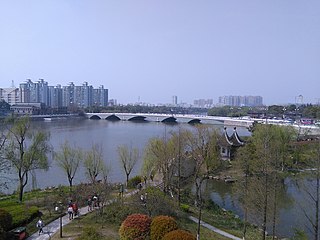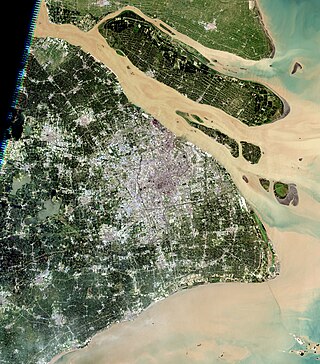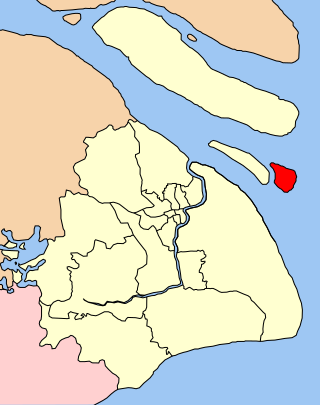Related Research Articles

Chongming District is the northernmost district of the provincial-level municipality of Shanghai. Chongming consists of three low-lying inhabited alluvial islands at the mouth of the Yangtze north of the Shanghai peninsula:Chongming,Changxing,and Hengsha. Following its massive expansion in the 20th century,Chongming is now the 2nd-largest island administered by the People's Republic of China and the 2nd-largest in Greater China,after Hainan. Chongming does not,however,administer all of the island:owing to its continual expansion from sediment deposited by the Yangtze,it has merged with formerly separate islands and now includes Jiangsu province's pene-exclave townships of Haiyong and Qilong. Chongming proper covers an area of 1,411 km2 (545 sq mi) and had a population of 704 000 at the time of the Sixth National Census in 2010.

Taicang is a county-level city under the jurisdiction of Suzhou,Jiangsu province,China. The city located in the south of the Yangtze River estuary opposite Nantong,being bordered by Shanghai proper to the south,while the river also delineates much of its northeastern boundary along Chongming Island.

Nantong is a prefecture-level city in southeastern Jiangsu province,China. Located on the northern bank of the Yangtze River,near the river mouth. Nantong is a vital river port bordering Yancheng to the north;Taizhou to the west;Suzhou,Wuxi and Shanghai to the south across the river;and the East China Sea to the east. Its population was 7,726,635 as of the 2020 census,3,766,534 of whom lived in the built-up area made up of three urban districts.

Chongming,formerly romanized as Chungming,is an alluvial island at the mouth of the Yangtze River in eastern China covering 1,267 square kilometers (489 sq mi) as of 2010. Together with the islands Changxing and Hengsha,it forms Chongming District,the northernmost area of the provincial-level municipality of Shanghai. At the time of the 2010 Chinese census,its population was 660,000.

Qidong is a county-level city under the administration of the prefecture-level city of Nantong in southeastern Jiangsu province,China. It is located on the north side of the Yangtze River opposite Shanghai and forms a peninsula jutting out into the East China Sea. It has a population of 1.12 million.

Zhangjiagang,formerly Shazhou County,is a county-level city under the administration of Suzhou,Jiangsu province,China and one of the many ports along the Yangtze river.

Tàizhōu is a prefecture-level city in central Jiangsu province in eastern China. Taizhou is also a member of the Shanghai metropolitan area.Situated on the north bank of the Yangtze River,it borders Nantong to the east,Yancheng to the north and Yangzhou to the west.

Shanghai has an expansive grade-separated highway and expressway network consisting of 16 municipal express roads,10 provincial-level expressways,and 8 national-level expressways. Three municipal expressways and four provincial-level expressways are also under construction.
The Chonghai Bridge is a proposed bridge to span the northern distributary at the mouth of the Yangtze River in the People's Republic of China. The bridge,along with the Chongqi Bridge and the Shanghai Yangtze River Tunnel and Bridge,is to connect the city of Shanghai with the north bank of the Yangtze in Jiangsu Province via Chongming Island.

Haimen is a district of Nantong,Jiangsu province,with a population of approximately 1 million. It is located at the opposite side of the Yangtze River to Shanghai and is directly north of Chongming Island except for a small portion that forms Haimen District's Haiyong Town. Haimen is the seat of the Roman Catholic Diocese of Haimen. Haimen is located in the poorer north Jiangsu region and together with Qidong City,traditionally has one of the highest rates of liver cancer in China and in the world,with upwards of 1 out of every 10 adults in the rural areas dying from liver cancer.
Nansha may refer to the following places:
Chongming-Qidong Yangtze River Bridge or the Chongqi Bridge,also called Chongqi Crossing Project,is a bridge across the north fork of the Yangtze River,near the river's mouth between Chongming Island of Shanghai and Qidong in Jiangsu Province. This bridge,along with the Shanghai Yangtze River Tunnel and Bridge to the south,forms the last crossing of the Yangtze River before the river empties into the East China Sea. The bridge carries the six-lane G40 Shanghai–Xi'an Expressway,part of the National Expressway Network of the People's Republic of China.

The geography of Shanghai is characterised by its location on the Yangtze River Delta on China's east coast and its proximity to the Pacific Ocean via the East China Sea. The city is centred on the Huangpu River,a tributary of the Yangtze River,and extends outwards in all directions,with the suburbs and satellite towns reaching east to the East China Sea,north and west to Jiangsu province,and south to Zhejiang province over Hangzhou Bay.

The islands of Shanghai are those under the jurisdiction of the Shanghai municipal government. They comprise three large inhabited islands and a shifting number of smaller,uninhabited ones. Most are alluvial islands in the Yangtze River Delta in China,although a number of islands in Hangzhou Bay off Jinshan District are also administered by Shanghai. The alluvial islands are relatively young and their number varies over time. In 2006,the city's 19 uninhabited islands covered 226.27 square kilometers (87.36 sq mi),with a total coastline length of 309 kilometers (192 mi).

Hengsha is a low-lying alluvial island at the mouth of the Yangtze River in eastern China. Together with the islands of Chongming and Changxing,it forms Chongming District,the northernmost area of the provincial-level municipality of Shanghai. Its population was 33,400 in 2008.

The Nanjing–Qidong railway,commonly referred to in short as the Ningqi railway,is a higher-speed rail line in Jiangsu Province,China. Its common name is derived from Ning,the one-character abbreviation for Nanjing and Qi,which refers to Qidong,a county-level city of Nantong.

The bridges and tunnels across the Yangtze River carry rail and road traffic across China's longest and largest river and form a vital part of the country's transportation infrastructure. The river bisects China proper from west to east,and every major north–south bound highway and railway must cross the Yangtze. Large urban centers along the river such as Chongqing,Wuhan,and Nanjing also have urban mass transit rail lines crossing the Yangtze.
Haiyong is a town of Haimen District in Nantong,Jiangsu,China. Together with neighboring Qilong,it forms a pene-enclave of the province on Chongming Island,most of which belongs to the province-level municipality of Shanghai. Haiyong presently covers about 12.5 square kilometers (5 sq mi) and had a population of 5,004 during the year 2000 census.
Yonglong may refer to:
Qilong is a township of Qidong in eastern Jiangsu province. The land it occupies was formerly Yonglongsha,a separate island in the Yangtze River delta,but reclamation projects and natural deposition of sediment have joined it to Chongming Island,where it now forms a pene-enclave within Shanghai's Chongming County. Its population was 3436 at the time of the 2010 Chinese census. Qilong's name—literally "opening prosperity"—is a compound of contracted forms of its county and its former island.
References
- ↑ International Journal of Sediment Research, Vol. XIII,p. 46. International Research & Training Centre on Erosion & Sedimentation (Beijing), 1998.
- ↑ Chen Jiyu & al. "The Model of Development of the Chang Jiang Estuary During the Last 2000 Years" in Estuarine Comparisons, p. 661. Academic Press (New York), 1982.
- 1 2 3 4 5 6 7 Office of Shanghai Chronicles. 岛、沙 Archived January 6, 2015, at the Wayback Machine ["Dǎo, Shā", "Islands and Shoals"]. Shanghai Municipal Government (Shanghai), 2015. Accessed 12 Jan 2015. (in Chinese)
- ↑ Gao Yuan (8 December 2004). "崇明上岸(長三角調查)[Chóngmíng Shàng'àn (Zhǎng Sānjiǎo Diàochá), Chongming Coast (Yangtze Delta Survey)]" (in Chinese). Beijing: People's Daily Online, Chinese Communist Party [Reprinted from East China News (Huádōng Xīnwén)]. Archived from the original on 25 January 2005.
- ↑ "关于启东兴隆沙开发问题 [Guānyú Qǐdōng Xīnglóngshā Kāifā Wèntí]" (in Chinese). Qidong: 农业新闻 [Nóngyè Xīnwén, Agricultural News] Qidong Agricultural Information Network. 24 May 2004. Retrieved 7 April 2015.. (in Chinese)
- ↑ "海永简介 [Hǎiyǒng Jiǎnjiè, "Haiyong Summary"]" (in Chinese). Haiyong People's Government. Retrieved 23 February 2015.